Connector system, apparatus and methods for a door frame assembly
Kendall March 9, 2
U.S. patent number 10,941,606 [Application Number 16/561,116] was granted by the patent office on 2021-03-09 for connector system, apparatus and methods for a door frame assembly. This patent grant is currently assigned to Endura Products, LLC. The grantee listed for this patent is Endura Products, Inc.. Invention is credited to Adam Kendall.
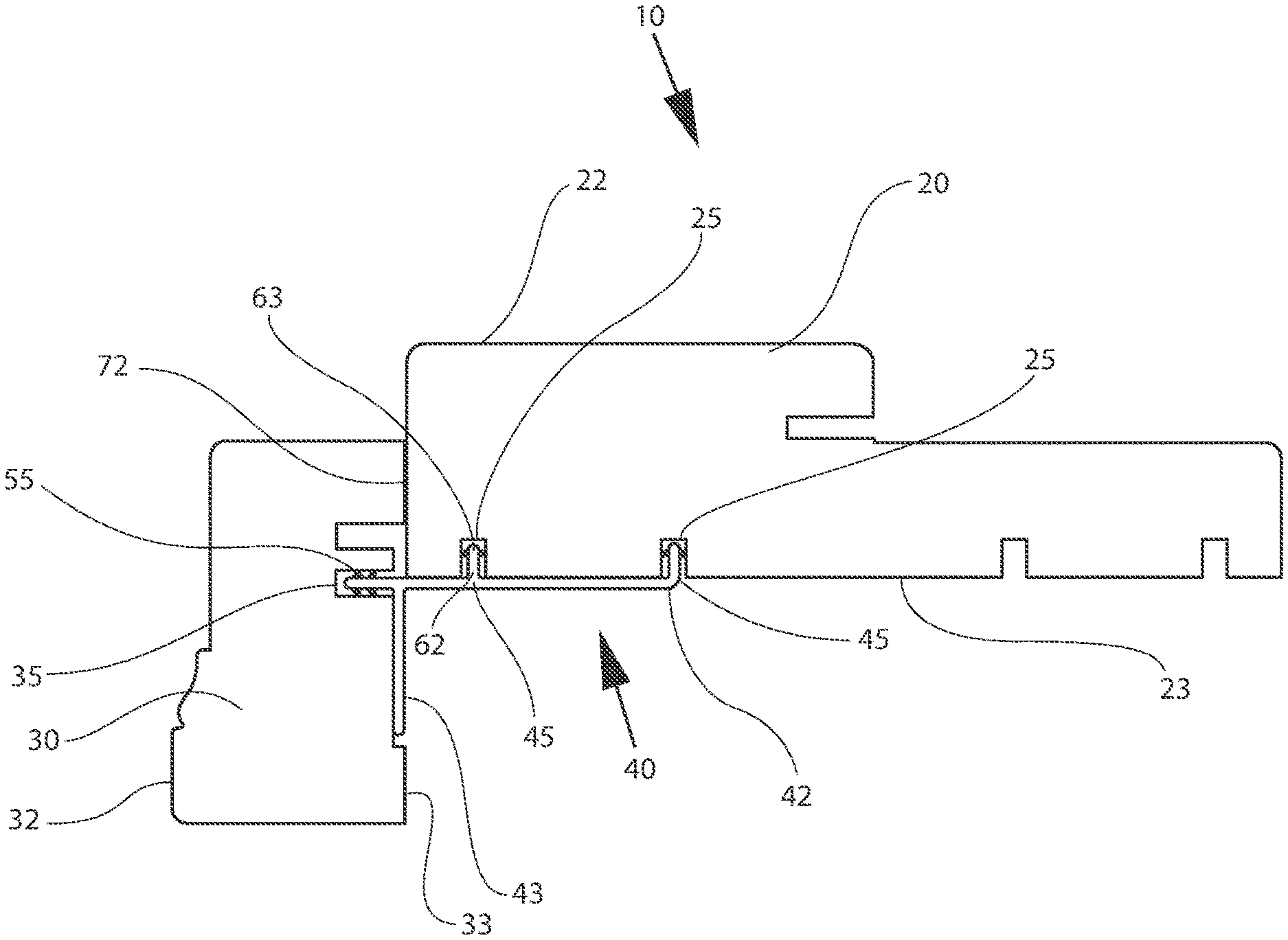
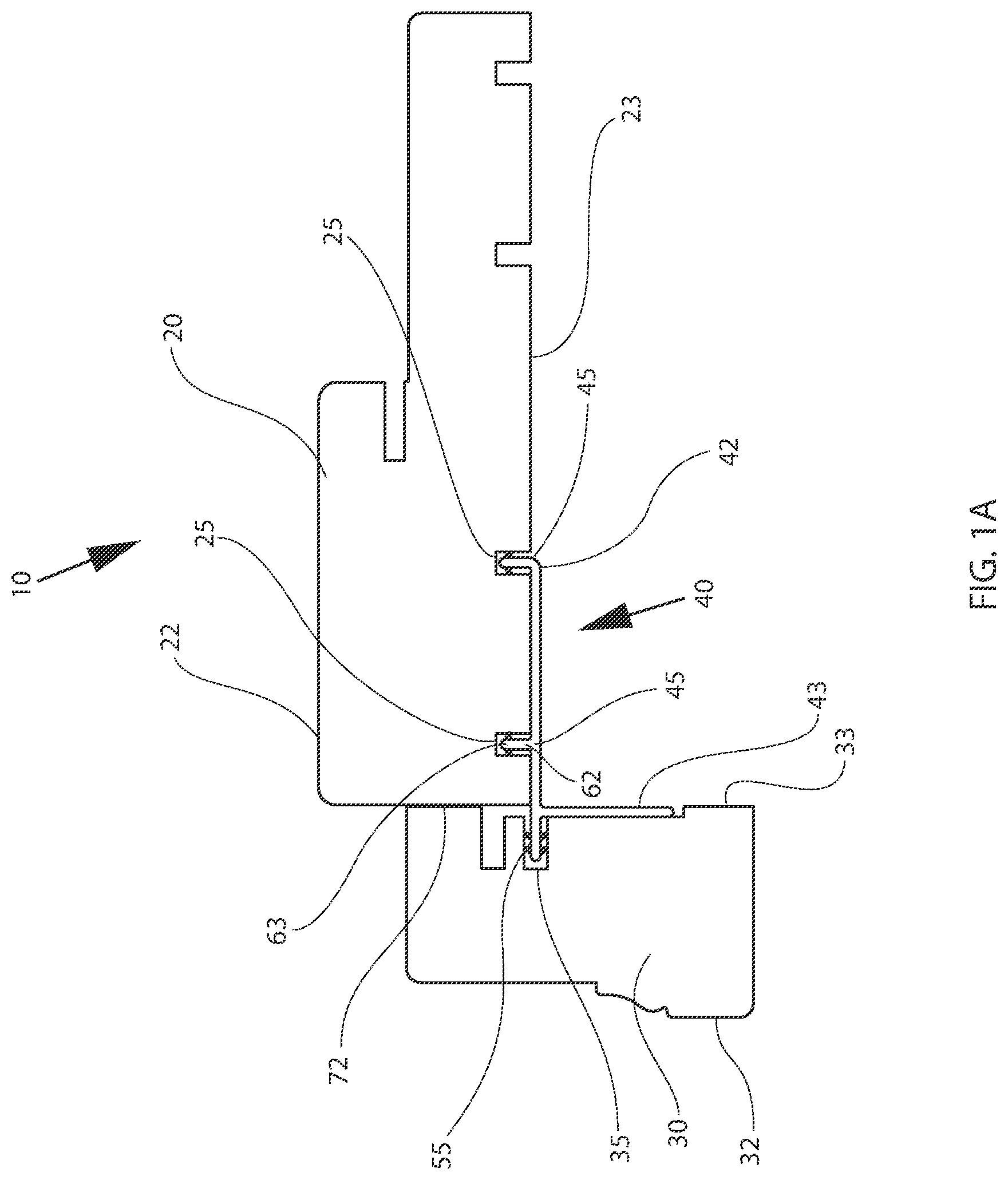
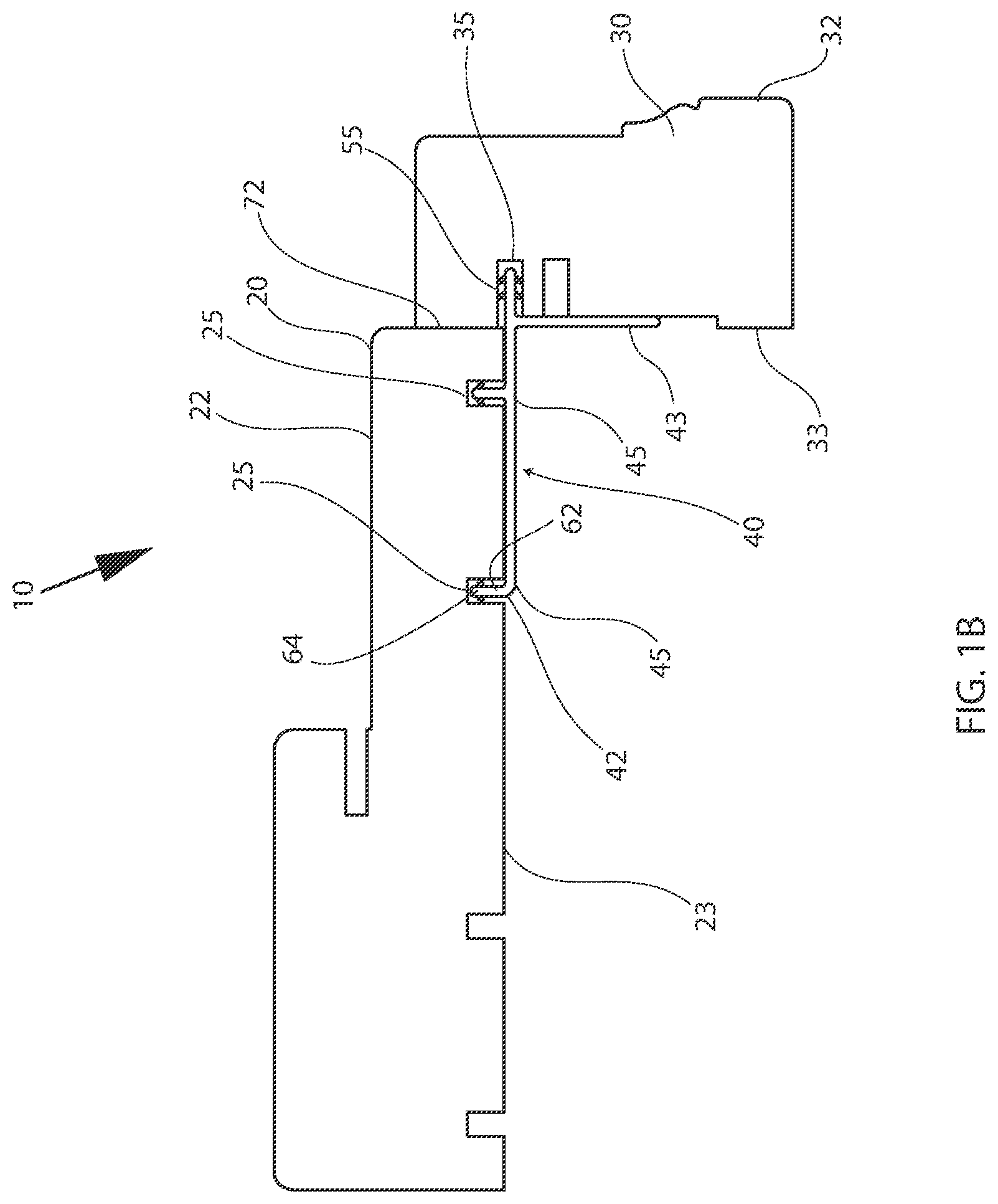
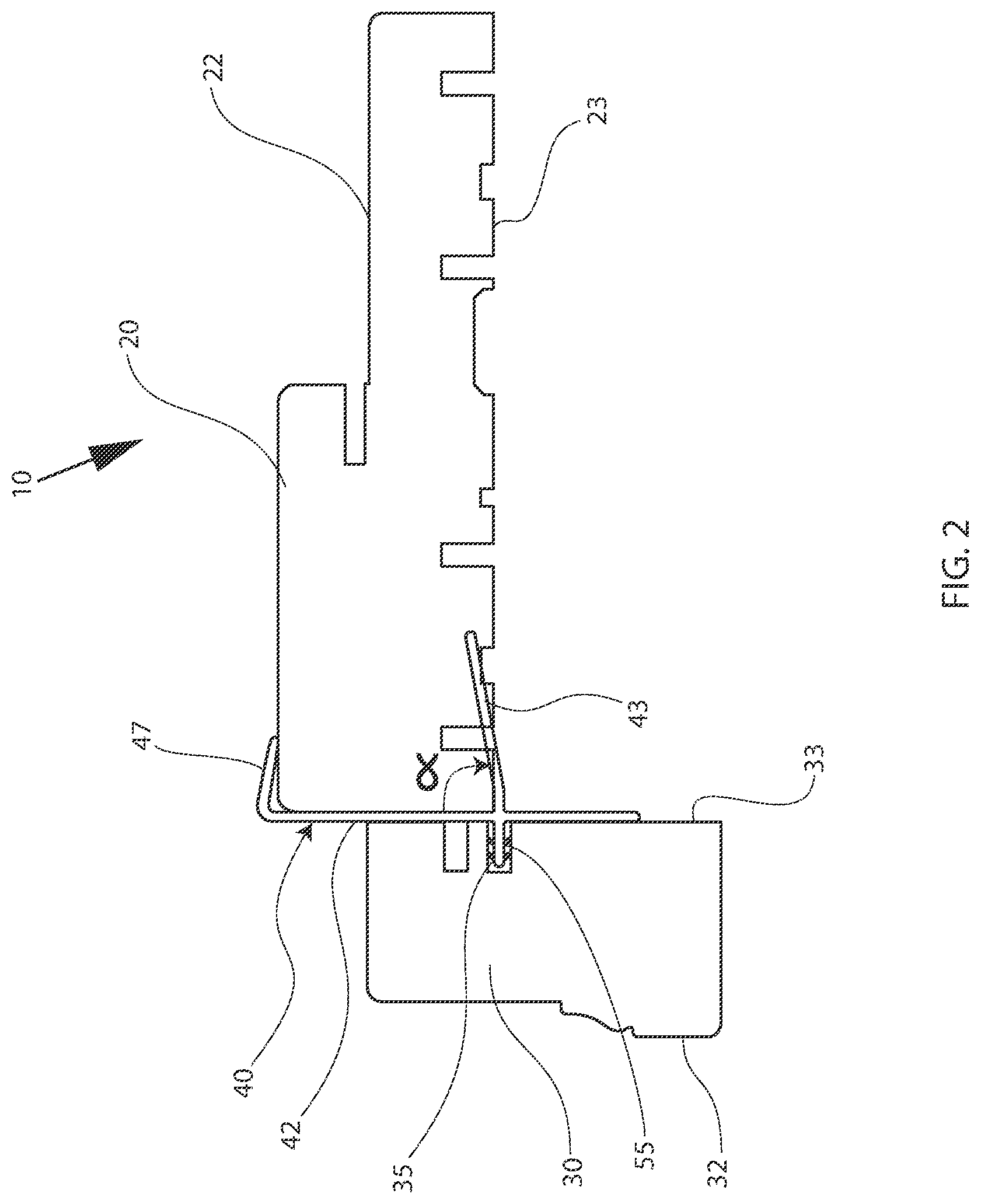
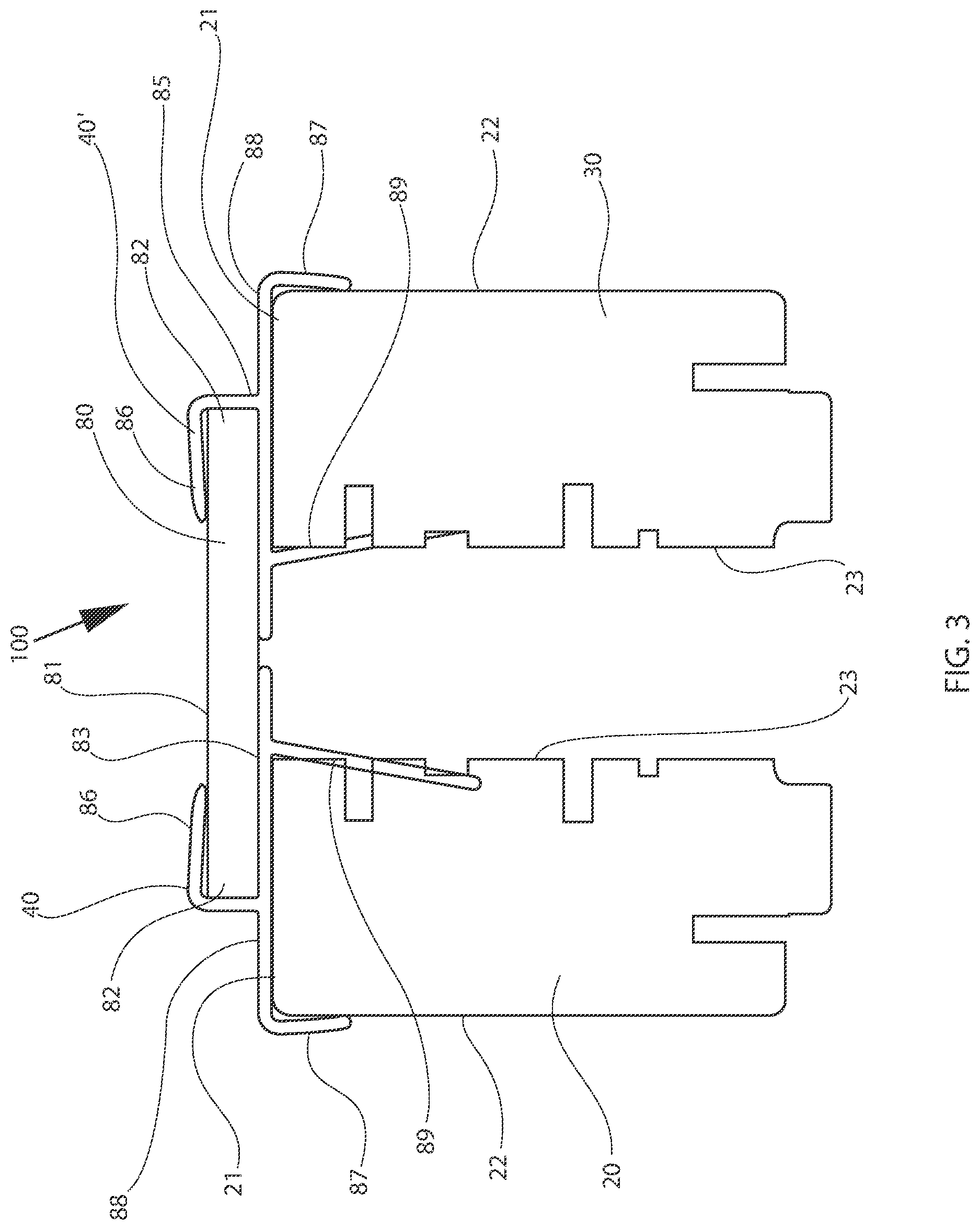
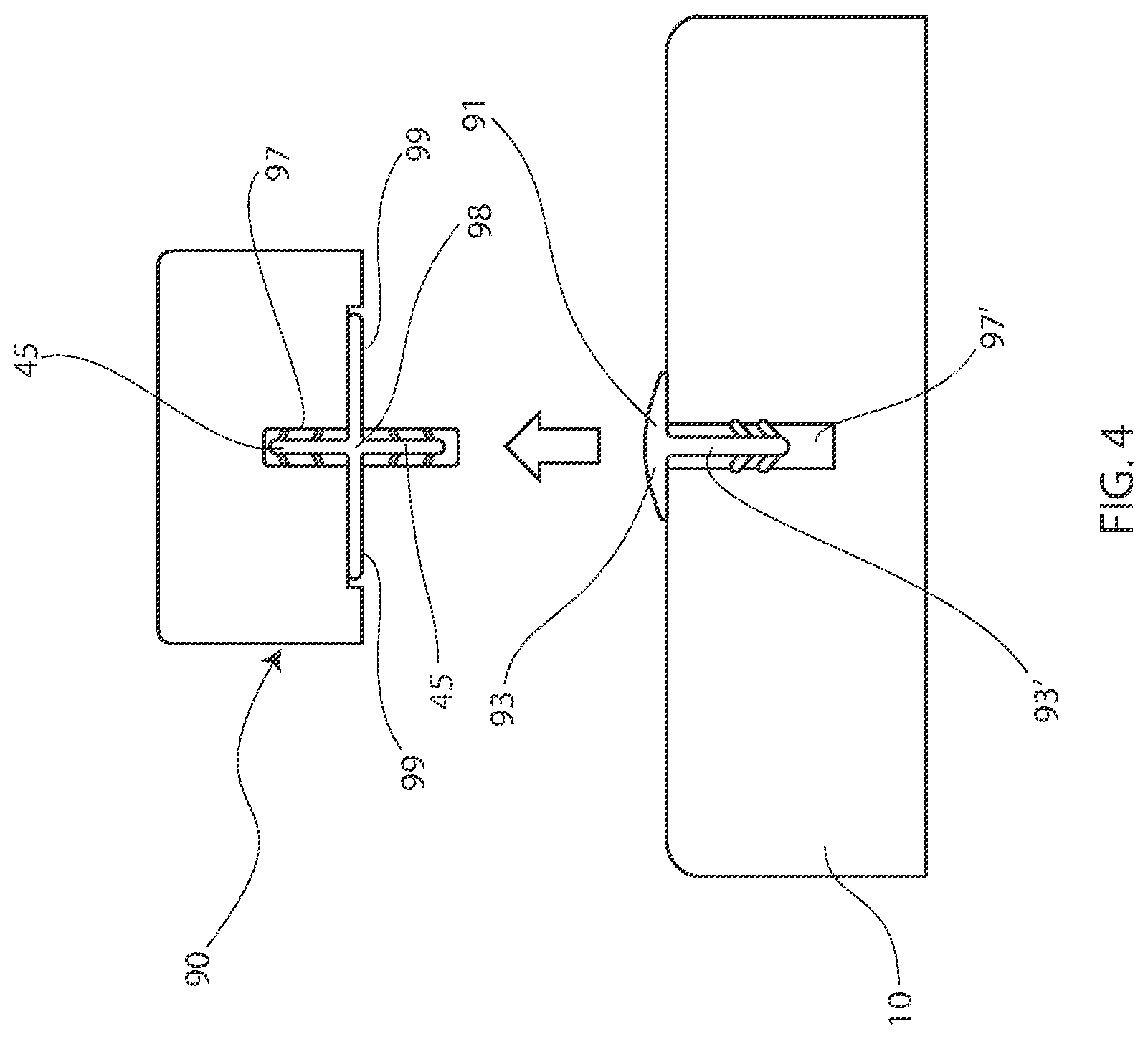
| United States Patent | 10,941,606 |
| Kendall | March 9, 2021 |
Connector system, apparatus and methods for a door frame assembly
Abstract
A system, device, assembly and methods for a frame assembly, including a connector as shown and described. The assembly may be a door frame assembly and may, by way of example, be a door jamb and/or a door mullion including a connector. A connector may provide stability to the assembly.
| Inventors: | Kendall; Adam (Burlington, NC) | ||||||||||
|---|---|---|---|---|---|---|---|---|---|---|---|
| Applicant: |
|
||||||||||
| Assignee: | Endura Products, LLC (Colfax,
NC) |
||||||||||
| Family ID: | 1000004423524 | ||||||||||
| Appl. No.: | 16/561,116 | ||||||||||
| Filed: | September 5, 2019 |
Related U.S. Patent Documents
| Application Number | Filing Date | Patent Number | Issue Date | ||
|---|---|---|---|---|---|
| 62727790 | Sep 6, 2018 | ||||
| Current U.S. Class: | 1/1 |
| Current CPC Class: | E06B 1/524 (20130101) |
| Current International Class: | E06B 1/52 (20060101) |
References Cited [Referenced By]
U.S. Patent Documents
| 1950519 | May 1932 | Ripley |
| 2317231 | April 1943 | Swedman |
| 2616531 | November 1952 | Young |
| 2863534 | December 1958 | Gillespie |
| 3371702 | March 1968 | Keegan et al. |
| 3609928 | October 1971 | Mock |
| 3774344 | November 1973 | Symons |
| 3991806 | November 1976 | Abell |
| 4086739 | May 1978 | Hall |
| 4184297 | January 1980 | Casamayor |
| 4258520 | March 1981 | Rehbein |
| 4330972 | May 1982 | Sailor |
| 4361979 | December 1982 | Petersson |
| 4407100 | October 1983 | Huelsekopf |
| 4452029 | June 1984 | Sukolics |
| 4454699 | June 1984 | Strobl |
| 4608796 | September 1986 | Shea, Jr. |
| 4665666 | May 1987 | Hampton |
| 4947597 | August 1990 | Simpson |
| 5003743 | April 1991 | Bifano et al. |
| 5027572 | July 1991 | Purcell et al. |
| 5062250 | November 1991 | Buzzella |
| 5182880 | February 1993 | Berge, Jr. et al. |
| 5261756 | November 1993 | Kohn |
| 5313755 | May 1994 | Koenig, Jr. |
| 5377464 | January 1995 | Mott et al. |
| 5378007 | January 1995 | Joyce |
| 5398468 | March 1995 | Erickson |
| 5448864 | September 1995 | Rosamond |
| 5491940 | February 1996 | Bruchu |
| 5528869 | June 1996 | Boomer et al. |
| 5540019 | July 1996 | Beske et al. |
| 5555684 | September 1996 | Galowitz et al. |
| 5590496 | January 1997 | Martin et al. |
| 5622017 | April 1997 | Lynn et al. |
| 5669192 | September 1997 | Opdyke |
| 5791113 | August 1998 | Glowa |
| 5836118 | November 1998 | Thornton et al. |
| 6098365 | August 2000 | Martin et al. |
| 6125605 | October 2000 | Young |
| 6141874 | November 2000 | Olsen |
| 6148584 | November 2000 | Wilson |
| 6293060 | September 2001 | McKann et al. |
| 6314701 | November 2001 | Meyerson |
| 6360508 | March 2002 | Pelfrey et al. |
| 6393779 | May 2002 | Boldt |
| 6491468 | December 2002 | Hagen |
| 6568137 | May 2003 | Ballantyne |
| 6578332 | June 2003 | Bushberger |
| 6588159 | July 2003 | Cotton, Jr. |
| 6604334 | August 2003 | Rochman |
| 6675545 | January 2004 | Chen et al. |
| 6761008 | July 2004 | Chen et al. |
| 6904726 | June 2005 | Heard et al. |
| 7165690 | January 2007 | Wu |
| 8276320 | October 2012 | Erbrect et al. |
| 9010066 | April 2015 | Sand |
| 9222267 | December 2015 | Bergelin et al. |
| 9249581 | February 2016 | Nilsson et al. |
| 9260871 | February 2016 | Shaw |
| 9387544 | July 2016 | Phebus et al. |
| 9534402 | January 2017 | Shaw |
| 9714673 | July 2017 | Phillips |
| 2002/0108326 | August 2002 | Ackerman, Jr. |
| 2003/0177725 | August 2003 | Gatherum |
| 2005/0257455 | November 2005 | Fagan |
| 2006/0174577 | August 2006 | O'Neil |
| 2007/0094985 | May 2007 | Grafenauer |
| 2009/0013636 | January 2009 | Wilson |
| 2010/0107524 | May 2010 | Moss |
Attorney, Agent or Firm: MacCord Mason PLLC
Claims
I claim:
1. A frame assembly for a doorway, comprising: a first frame member having an outside exposed surface, and an inside surface, at least one groove recessing into the first frame member along the inside surface, a second frame member having an outside exposed surface and an inside surface, a second groove recessing into the second frame member along the inside surface, a connector separate from the first frame member and second frame member and joining the first frame member and the second frame member with each other, said connector including a first wall and a second wall, the first wall being substantially perpendicular to the second wall, at least a first projection extending from the first wall, the first projection configured to align with one of the at least one grooves, a second projection extending from the second wall, the projection configured to align with the second groove, wherein said connector interfaces with the inside surfaces of the first frame member and the second frame member, abutting with and extending along the inside surfaces, and the connector is not visible from the outside surface of the frame assembly, the connector securing said first frame member to said second frame member in an abutting position.
2. The frame assembly of claim 1, wherein said connector spans the inside walls of the first frame member and the second frame member but does not protrude between a meeting face of the first frame member and the second frame member.
3. The frame assembly of claim 1, said projections being linear projections.
4. The frame assembly of claim 3, said projections including an attachment end and terminating end.
5. The frame assembly of claim 4, the projections including a set of barbs positioned between the attachment end and the terminating end.
6. The frame assembly of claim 1, wherein the first set of projections point in a first direction and the second projection points in a second direction.
7. The frame assembly of claim 1, wherein said second projection extends linearly along a same plane as the first wall.
8. The frame assembly of claim 7, wherein said second projection extends beyond a plane formed by the first wall.
9. The frame assembly of claim 1, wherein said connector forms a solid joint wall at the intersection of the first frame member and the second frame member.
10. The frame assembly of claim 1 wherein said frame assembly includes more than one connector.
11. A door frame assembly comprising: a connector for a frame member, a door frame member, said door frame member including: a first frame member being a door iamb and having an outside exposed surface, and an inside surface, at least one groove recessing into the first frame member along the inside surface, a second frame member having an outside exposed surface and an inside surface, a second groove recessing into the second frame member along the inside surface, an extension member, wherein said connector mates with the inside surfaces of the first frame member and second frame member and extends into a groove on a surface of the first door frame member and also into a surface of the second member, said connector being enclosed within a joint formed between the door frame members, said connector providing a support for the over all door frame assembly.
Description
FIELD OF TECHNOLOGY
The present disclosure relates generally to doors and door assemblies for entranceways for example, for a building and, more particularly, to a door frame and connector system, device, apparatus, and/or methods for a door assembly for a residence/facility.
BACKGROUND
Joining of frame members for a door assembly is traditionally accomplished with fasteners such as staples, nails or screws. When these fastener types are used, a secondary operation is needed to hide the fastener in situations where improved aesthetics are desired. There can be opposing variables between securing a door frame and maintaining an aesthetically desirable appearance to the door assembly.
Thus, the Applicant recognized there remains a need for a new and improved connector for joining door frame members for door assemblies, and it is to these and other challenges that the inventions of the present disclosure are directed.
SUMMARY
The present disclosure is directed in one embodiment to a system, device, method and/or kit for joining of framing members for a door assembly by way of alternate fastening methods, by way of example, through a connector and an internal groove or set of grooves on adjoining frame members. In one example, the connector may mate with and be inserted into a groove of one or more frame members, when the frame members are abutted. As a connector and groove system joins the connector and groove and the connector and groove are assembled through abutment of the framing members, the connector may be hidden on an inside surface of the frame members.
In another embodiment, a frame assembly for a doorway may include a first frame member, a first set of grooves, a second frame member, a second set of grooves and a connector. The first frame member may include an outside exposed surface, and an inside surface. The first set of grooves may be recessed into the first frame member along the inside surface. The second frame member may include an outside exposed surface and an inside surface. The second groove may recess into the second frame member along the inside surface. The connector may join the first frame member and the second frame member with each other. The connector may include a first wall and a second wall. The first wall may be substantially perpendicular to the second wall.
Some embodiments may include a set of first projections extending from the first wall. The set of first projections may be spaced apart from one another and configured to align with the first set of grooves. An at least one second projection may extend from the second wall. The projection may be configured to align with the second groove.
A connector may be a hidden connector. The connector may span the inside surfaces of the first frame member and the second frame member and not be fully or partially visible from the outside surface of the frame assembly. The connector may secure the first frame member to said second frame member in an abutting position.
In other embodiments, the connector may span the inside walls of the first frame member and the second frame member but not protrude between a meeting face of the first frame member and the second frame member. The connector may extend at least halfway along the length of the first frame member and the connector may extend less than halfway along the length of the second frame member.
Some examples of a frame assembly for a doorway may include a first frame member having an outside exposed surface, an end surface, and an inside surface, and a second frame member having an outside exposed surface, an end surface, and an inside surface. A bridge member may have an outside surface, an end surface and an inside surface. A first connector may join the first frame member and the bridge with each other. A second connector may join the second frame member and the bridge with each other. The first connector, second connector and the bridge member may form a collective end wall. The first frame member and the second frame member may be spaced apart from one another by the end wall. The first connector and the second connector may be configured to include an opposed position to one another.
The first connector and the second connector may include a side cap, an end cover, an end extension piece for accepting the bridge, and an inside securing projection extending at an angle to the frame member. The inside securing projection may attach the respective connector to the respective inside surface of each respective frame member.
In some instances, the end cover of the first connector and the end cover of the second connector extend in a first plane with the securing projection for each frame member extending non-perpendicularly to the first plane. The securing projection of each first connector and second connector may extend from the first plane from at a range of an angle alpha. The angle alpha may be a 90 degree angle. The angle alpha may be in a range of between 70 and 100 degrees. The angle alpha, in other examples, may extend between a range of between 80 and 90 degrees. The listed ranges are exemplary and the angle alpha could include other dimensions, ranges and/or any of the ranges within or outside of those listed as examples.
The first connector and the second connector may be separated from one another by said bridge member. The first connector and the second connector may extend from one another. The first connector and second connector may form one piece.
In some examples, a frame member may be a jamb, a mullion, a bridge, a trim piece, and/or a combination of any of these listed.
The inventions of the present disclosure include forming a mullion by way of a set of opposing jambs, a set of opposing extenders and a bridge.
Other examples include a frame assembly including an end wall forming a complete end cap covering the first and second frame members. There may be a space formed in-between, and the projection for the first connector and the second connector may be encased inside an interior space between the first frame member inside surface and the second frame member inside surface.
The inventions of the present disclosure may be considered a method for securing a doorway frame joint by way of any of the embodiments disclosed herein.
The inventions of the present disclosure may be considered a connector for a door frame according to any of the embodiments disclosed herein.
These and other aspects of the inventions of the present disclosure will become apparent to those skilled in the art after a reading of the following description of embodiments when considered with the drawings.
BRIEF DESCRIPTION OF THE DRAWINGS
FIG. 1A is a cross-sectional view of one embodiment of a frame assembly for a door constructed according to the present disclosure;
FIG. 1B is a cross-sectional view of another embodiment of a frame assembly for a door frame constructed according to the present disclosure;
FIG. 2 is a side view of another embodiment of a frame assembly for a door frame constructed according to the present disclosure;
FIG. 3 is a side view of another embodiment of frame assembly for a mullion door frame constructed according to the present disclosure; and
FIG. 4 is a side view of one example of a groove cover and extension for a frame member according to the present disclosure.
DESCRIPTION OF EMBODIMENTS
In the following description, like reference characters designate like or corresponding parts throughout the several views. Also in the following description, it is to be understood that such terms as "forward," "rearward," "left," "right," "upwardly," "downwardly," and the like are words of convenience and are not to be construed as limiting terms.
Referring now to the drawings in general, it will be understood that the illustrations are for the purpose of describing a preferred embodiment of the inventions and are not intended to limit the inventions thereto. A door frame often includes one or more frame members. A plurality of frame members may include any combination of a header, a sill, mullion components, jamb components, and/or a trim component. A header may be generally placed toward the top of a door assembly. Mullions and jambs components may be generally placed at opposing sides of a door panel. Frame assemblies may also include hinges for connecting door panels to at least one of the frame members. The frame assembly may also include locking hardware that enables the door to be secured to as least one of the frame members and/or to another frame member. Locking hardware, by way of example, may include latch and deadbolt plates.
FIGS. 1A, 1B, and 2 show, in one embodiment, a door frame assembly 10 for a door frame. A frame assembly 10 for a doorway may include a first frame member 20 having a first set of grooves 25, a second frame member 30 having a second set of grooves 35, and a connector 40. The first frame member 20 may include an outside exposed surface 22, and an inside surface 23. The first set of grooves 25 may be recessed into the first frame member 20 along the inside surface 23. The second frame member 30 may include an outside exposed surface 32 and an inside surface 33. The second groove 35 may recess into the second frame member 30 along the inside surface 33.
The connector 40 may assist in joining the first frame member and the second frame member with each other. The connector 40 may include a first wall 42 and a second wall 43. The first wall may be substantially perpendicular to the second wall.
A connector 40 may be a hidden connector. The connector 40 may span the inside surfaces 23, 33, of the first frame member 20 and the second frame member 30 and not be fully or partially visible from the outside surfaces of the frame assembly 22, 32. The connector 40 may secure the first frame member 20 to the said second frame member 30 in an abutting position.
In other embodiments, the connector 40 may span the inside walls 23, 33 of the first frame member 20 and the second frame member 30 but not protrude between a meeting face 72 of the first frame member 20 and the second frame member 30. The connector 40, in some embodiments, may extend at least halfway along the length of the first frame member 20, and may extend less than halfway along the length of the second frame member 30. The first wall 42 may be longer than the second wall 43. The second wall may or may not include second projections 55. The second projection 55 may be an extension of the first wall 42 that extends past an intersection with the second wall 43.
Some embodiments may include a set of first projections 45 extending from the first wall 42. The set of first projections 45 may be spaced apart from one another and configured to align with the first set of grooves 25. An at least one second projection 55 may extend from the second wall 43. The projection 55 may be configured to align with the second groove 35. Projections 45, 55 may be linear projections. Projections 45, 55 may include an attachment end 62 and a terminating end 63. Projections 45, 55 may include one or a set of barbs 64. The barbs 64 may be positioned between the attachment end 62 and the terminating end 63. The barbs may be made of coextruded flexible material to help maintain engagement of the projections 45, 55 within the grooves.
Projections 45, 55, in some examples, may include a first set of projections 45 oriented and/or pointing in one direction and a second projection 55 oriented and/or pointing in a different, second direction.
In some examples, a second projection 55 may extend linearly along a same plane as a first wall 42. The second projection 55 may project beyond a plane formed by the second wall 43.
The frame assembly may, by way of example, be configured to form a trisecting jointed wall between the first frame member 20, second frame member 30 and connector 40, one example as shown in FIG. 2.
Some examples of a frame assembly 100 for a doorway, one example of which is seen in FIG. 3, may include a first frame member 20 having an outside exposed surface 22, an end surface 21, and an inside surface 23, and a second frame member 30 having an outside exposed surface 22, an end surface 21, and an inside surface 23. A bridge member 80 may have an outside surface 81, an end surface 82, and an inside surface 83. A first connector 40 may join the first frame member 20 and the bridge member 80 with each other. A second connector 40' may join the second frame member 30 and the bridge member 80 with each other. The first connector 40, second connector 40' and the bridge member 80 may form a collective end wall 85. The first frame member 20 and the second frame member 30 may be spaced apart from one another by at least a portion of the end wall 85. The first connector 40 and the second connector 40' may be configured to take on an opposed position configuration to one another.
The first connector 40 and/or the second connector 40' may include a side cap 87, an end cover 88, and an end extension piece 86 for accepting the bridge member 80, and an inside securing projection 89 extending at an angle to the frame member 20, 30. The inside securing projection 89 may attach the respective connector 40, 40' to the respective inside surface 23 of each respective frame member. The projection 89 may be secured to the frame member by a fastener, such as, by way of example, a staple, adhesive, or a nail.
In some instances, the end cover 88 of the first connector 40 and the end cover 88 of the second connector 40' extend in a first plane with the securing projection 89 for each frame member extending non-perpendicularly to the first plane. The securing projection 89 of each first connector 40 and second connector 40' may extend from the first plane from at a range of an angle alpha. The angle alpha may be a 90 degrees angle. The angle alpha may be in a range of between 70 and 100 degrees. The angle alpha, in other examples, may extend between a range of between 80 and 90 degrees. The listed ranges are exemplary and the angle alpha could include other dimensions, ranges and/or any of the ranges within or outside of those listed as examples.
The first connector 40 and the second connector 40' may be separated from one another by a length of the bridge member 80. The first connector 40 and the second connector 40' may extend from one another. The first connector and second connector may form one piece.
In some examples, a frame member assembly may be a jamb, a mullion, a bridge, a trim piece, and/or a combination of any of these listed.
The inventions of the present disclosure include forming a mullion by way of a set of opposing jambs, a set of opposing extenders and a bridge.
In some examples, an extension piece for accepting the bridge member 80 forms a U-shaped acceptor.
In examples of a frame assembly 10, for example, a jamb or a mullion, an extension member 90 may be included and may attach to a frame assembly 10, an example of an extension being partially shown in FIG. 4. The extension member 90 may include a groove 97. The frame member 10 may include a groove 97'. When a groove is not in use in the frame member 10, a groove cover 91 may be utilized and fitted into the groove. The groove cover may have a top 93 that covers a groove opening and a groove cover projection 93'. The groove cover may take on a configuration similar to the projections as disclosed herein. A joint extension 98 may alternatively project into groove 97 and on one side and groove 97' on an opposite side. The joint extension 98 may include projections 45, and may have arms 99 that extend, in some examples, perpendicularly to projections 45. The joint extension 98 may serve to secure the frame member 10 to the extension member 90.
Other examples of the enclosed embodiments include a frame assembly 100 including an end wall forming a complete end cap covering the first 20 and second frame members 30. There may be a space formed in-between the frame members 20, 30, and the projection 89 for the first connector 40 and the second connector 40' may be encased inside an interior space between the first frame member inside surface 23 and the second frame member inside surface 23. The projection 89 may an interior space and also extend into the inside surface 23 respectively of first frame member 20 and second frame member 30.
The inventions of the present disclosure may be considered a method for securing a doorway panel joint by way of any of the embodiments disclosed herein.
The inventions of the present disclosure may be considered a connector for a door panel according to any of the embodiments disclosed herein.
Certain modifications and improvements will occur to those skilled in the art upon a reading of the foregoing description. It should be understood that all such modifications and improvements have been deleted herein for the sake of conciseness and readability but are properly within the scope of the following claims.
* * * * *
D00000

D00001

D00002

D00003

D00004

D00005

XML
uspto.report is an independent third-party trademark research tool that is not affiliated, endorsed, or sponsored by the United States Patent and Trademark Office (USPTO) or any other governmental organization. The information provided by uspto.report is based on publicly available data at the time of writing and is intended for informational purposes only.
While we strive to provide accurate and up-to-date information, we do not guarantee the accuracy, completeness, reliability, or suitability of the information displayed on this site. The use of this site is at your own risk. Any reliance you place on such information is therefore strictly at your own risk.
All official trademark data, including owner information, should be verified by visiting the official USPTO website at www.uspto.gov. This site is not intended to replace professional legal advice and should not be used as a substitute for consulting with a legal professional who is knowledgeable about trademark law.